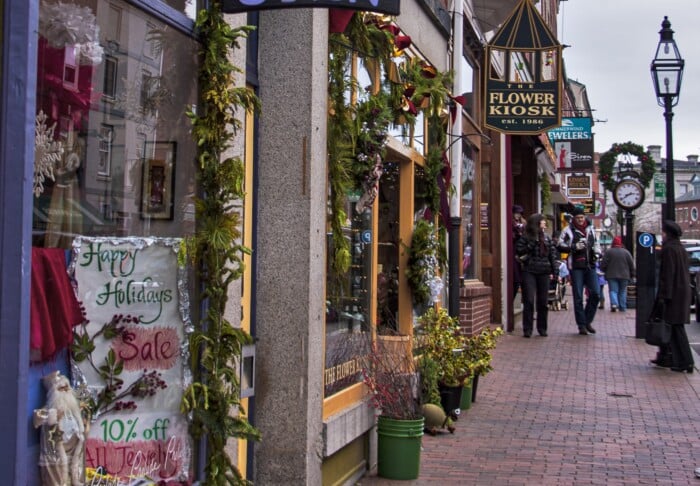Island Life and the History of New Castle
A look at the lively life of NH's only island town

Courtesy David J. Murray, ClearEyePhoto.com
What was once Great Island has, for the last two centuries, been lashed to the mainland with a series of bridges. By car, starting at the south end of Portsmouth, you can travel what locals call “the loop” in under 10 minutes. Route 1B hops over Shapleigh and Goat islands with a drop-dead view, to your left, of the swirling Piscataqua River and Portsmouth Naval Shipyard in Kittery, Maine.
The narrow winding road lures visitors into the picture-perfect village with its single white church, an elementary school, one eatery, a tiny post office, pocket-sized graveyard and town hall. A ruined fort and a restored lighthouse hunker just out of sight as you turn sharply to the right. There’s a seaside town common, a marina and the gleaming Wentworth by the Sea Hotel. Then you skip across a singing metal bridge and, following one scenic minute in Rye, you’re back in Portsmouth.
You can still circumnavigate the island in a small boat, but beware. The Back Channel — known to residents as “The Pool” — includes a cluster of miniature islands that appear to float on a glassy surface. Passing under the Route 1B bridge, however, your little boat meets one of the world’s fastest flowing rivers.
1600s: Governors, witches and devils
Sadly, we know almost nothing about 12,000 years of indigenous life on the island. No archeological studies yet exist. The colonial clock begins in 1623 when New Hampshire’s first English settlers built their trading and fishing post at what is now Odiorne State Park in Rye. But it’s a fair bet that founder David Thompson planned to claim ownership of Great Island. Then, he suddenly moved to Boston and disappeared into history.

Costumed locals reenact the arrival of Paul Revere in Portsmouth that sparked the December 1774 powder raid at Fort William and Mary.
Photograph by Ralph Morang.
For the rest of the 17th century, Great Island was the hub of the Strawbery Banke Colony and the town of Portsmouth. The population clustered around a crude fort, a defense against English pirates and French privateers. The island was home not only to humble fishing families, but to a string of wealthy royal governors appointed by the English king. Most sessions of the General Court were held here, making Great Island effectively the capital of provincial New Hampshire.
These were turbulent times. Three thousand miles away, King Charles I was beheaded by Puritan forces. A decade later, when his son Charles II regained the throne, the severed head of Puritan leader Oliver Cromwell was displayed on a pole outside Westminster Hall in London.
Back on Great Island, life was chaotic. In 1652, five local selectmen destroyed and rewrote the colony records to suit their needs. Jane Walford, the wife of a prominent landowner, was accused by her island neighbors of being a witch. British governor Edward Cranfield tossed Portsmouth’s Puritan minister Joshua Moody in jail for failing to follow Anglican church rituals, and locals then drove the corrupt governor out of town. In 1682, Quaker tavern owner George Walton was pelted by rocks from an unseen source, creating the legend of an invisible “Stone Throwing Devil.”

Soldiers pose around the deteriorating gate of Fort Constitution after the Civil War. Photo courtesy of New Castle Historical Society.
Then in 1692, 19 “great guns” arrived at Great Island, a gift from the new king and queen. Sent to bolster Portsmouth Harbor defenses, the cannons were installed at the fort, renamed Fort William and Mary in honor of the monarchs. The following year, with royal permission, islanders broke away from Portsmouth to establish the town of New Castle. Residents were required to pay the Crown a symbolic annual rent of one peppercorn.
1700s: The Revolution starts here
As English wars with the French escalated, the fort at New Castle became a key colonial defense on the Atlantic coast. A showdown between the colonists of New England and New France (Canada) was inevitable. In 1710, Colonel Shadrach Walton of New Castle commanded 1,500 New England men, 100 of them from New Hampshire. His ragtag militia joined the British siege on Port Royal, the capital of French Arcadia. They won the day. In the resulting peace treaty, France ceded its control of Nova Scotia and Newfoundland, a huge British victory.
In spring 1745, 500 New Hampshire men boarded a dozen transport ships at Fort William and Mary. They joined 4,000 New Englanders headed to Cape Breton, where they seized the seemingly impregnable Fort Louisbourg. All but forgotten today, the victory over this French stronghold was a gigantic moment in local history. New Englanders discovered that a militia made of farmers, fishermen, and shopkeepers could unite to defeat a common enemy. It was a lesson they would not forget.
Piscataqua settlers had long enjoyed a rowdy reputation. In the 1760s, they rioted over the Stamp Act, burned the tax collector in effigy and shipped crates of imported tea back to England. Defiant subjects of the king, soon to be called “patriots,” were growing bolder year by year. “Everything is unhinged,” one Loyalist exclaimed, “and running into confusion.”
New Hampshire historians have long proclaimed (though largely ignored) that the American Revolution began in New Castle, rather than on the bloody battlefields of Lexington and Concord. On a snowy night in December 1774, a Boston silversmith named Paul Revere galloped into the thriving seaport of Portsmouth.

Flat-bottomed gundalows carried the stolen gunpowder inland. Some of the powder found its way by ox cart to the Battle of Bunker Hill. Photo courtesy of the Gundalow Company.
Revere announced that British troops were on their way to block colonists from getting their hands on gunpowder and weapons at the king’s armory in New Castle. Revere was wrong, but his words lit a fuse. Fired by the call of fife and drum, as many as 400 residents clambered onto flat-bottomed barges called “gundalows.”
Only six soldiers were guarding the New Castle fort as the mob approached. The soldiers fired 4-pound iron balls from three cannons, injuring no one. Before they could reload, rioters stormed the fort on all sides and pulled down the English flag. It was British citizen versus British citizen, neighbor against neighbor. A hundred barrels of powder were stolen from the king’s armory. Some of it would show up at the battle of Bunker Hill the following spring.
Despite the treasonous action, royal governor John Wentworth knew it was fruitless to arrest anyone. The tide was turning against 150 years of British rule. Two leaders of the raid, merchant John Langdon and lawyer John Sullivan, would later become governors of New Hampshire.
Threatened by the Portsmouth mob, Sir John Wentworth and his family were forced to abandon their downtown mansion and hide out at the New Castle fort. The once popular leader, a founder of Dartmouth College, was warned never to step foot in New Hampshire under penalty of death.
1800s: The historian and the hotel
For decades following the American Revolution, New Castle was a sleepy fishing hamlet, connected to the mainland only by rickety, wooden toll bridges. Four surnames made up almost 40% of the population and taxes were paid in barrels of fish. The old stronghold, renamed Fort Constitution, was manned for the War of 1812 and the Civil War, but as in the past two centuries, no enemy appeared.
As the bloody war between the states wound down, a bookish former teacher from Massachusetts named John Albee arrived in New Castle. The future island historian and his new wife, Harriet, paid $1,775 for 28 acres of waterfront land. A decade later, on a high point not far from the Albee farm, Charles and Sarah Campbell built their dream business. Opened in 1874, their boxy Wentworth Hotel offered stunning views of the Isles of Shoals shimmering in the distance.
The Campbells, however, quickly went bankrupt. They sold their beloved hotel to “ale tycoon” Frank Jones, a former Portsmouth mayor and New Hampshire congressman. Jones’ empire included a bank, insurance company, a theater, railroad lines, utilities, office buildings, a racing stable and more. Funded by Jones, the hotel grew to three times its original size with distinctive towers and a sloping mansard roof.
The Wentworth soon joined the top luxury destinations on the Atlantic coast with golf and tennis courts, a marina, ballroom, riding stables, bowling alley, flush toilets, steam elevators and massive dining area. Down the road at Fort Constitution, an iconic new lighthouse, built of iron and lined in brick, stood boldly against the sea.

Poet, teacher and gentleman farmer, John Albee published his highly readable “New Castle: Historic and Picturesque” in 1884. Photo courtesy of J. Dennis Robinson Collection.
Frank Jones hired John Albee, the local poet, to write about the now famous island. Albee’s “New Castle, Historic and Picturesque” (1884) regaled Victorian visitors with tales of witches, forts, fishermen and stone-throwing devils. New bridges, trains and trolleys brought tourists from polluted cities to the healthful salt sea air.
Despite nearly 20 years as a tax-paying resident of New Castle, Albee accepted his status as an outsider and his role as somewhere between a tour guide and a gossip columnist. His summer house guests included poets Celia Thaxter and Henry Wadsworth Longfellow, Boston publisher James T. Fields and inventor Alexander Graham Bell.
1900s: War and peace and sanitation
In 1905, the Wentworth Hotel hosted delegates from Russia and Japan. The successful Treaty of Portsmouth ended the Russo-Japanese War and brought international attention to the tiny New Hampshire town. The historic island had become so attractive that the Portsmouth Herald launched an editorial campaign to “Annex New Castle.” Rejoining Portsmouth after 200 years, the newspaper editor suggested, would provide New Castle with a fresh water and sewer system, new trolley car lines, and police and fire protection. “We do not need a costly sewerage system, for every house can drain right into the river,” one New Castle resident explained.
Through two world wars, New Castle again stood sentry at the mouth of the Piscataqua River, protecting Portsmouth and the bustling shipyard in Kittery. Despite local opposition, what is now the scenic Town Common, became Camp Langdon. By February 1940, the military camp included 20 barracks, seven mess halls and a 50-bed hospital.
Soldiers at nearby Fort Stark tested their high-powered searchlights and massive artillery guns. The harbor was heavily mined against invading Nazi U-boats. The hotel was shuttered during World War II, and island residents were required to carry ID cards. By war’s end, New Castle’s three centuries as a key coastal defense site was over.
The revival of the town’s tourist business began immediately with the sale of Wentworth by the Sea in March 1946. Margaret and Jamesarker Smith, two “come-from-aways,” purchased the exclusive hotel on 256 acres for under $300,000. They maintained the rambling summer resort through changing times for 36 years, then sold it in 1980.
“It was first-class all the way, real New England elegance,” Jim Smith reminisced to the Washington Post in 1982. “No matter how historic the hotel is, when it gets old, it gets old; just like people.”
For the rest of the century the shuttered hotel on the hill deteriorated, occupied only by raccoons and pigeons. Over two decades, under nine owners, the property surrounding the hotel would shrink to just four acres. The closing of Wentworth by the Sea seemed to fill islanders with an aching nostalgia. New Castle was different, but visitors still swarmed the storybook village as real estate prices rose.
The town that John Albee called “the little kingdom” was forced to face critical community issues of fire, police, fresh water and what one spokesperson delicately called “effluvia.” At first, islanders chose not to install a $1 million municipal sewer system by a vote of 138-0. But the threat of massive government fines for polluting the surrounding waters changed the equation. State officials decreed that New Castle must pay to connect to a new waste treatment plant being built at Portsmouth, thus ending decades of “sewer squabbles.”
Today: The challenge of change

Lighthouse and oilhouse at Fort Point restored and maintained by the Friends of Portsmouth Harbor Lighthouse, a nonprofit organization. Photo courtesy of J. Dennis Robinson.
A wave of growth and renewal swept ashore as Great Island entered its fifth century. A new library appeared as the old library became the historical society. A nonprofit group preserved and restored the endangered lighthouse. Volunteers cleared the ruins of Fort Stark, now a waterfront state historic site.
Saved from destruction in the eleventh hour by owners Ocean Properties, the hotel on the hill reopened in 2004. The $25 million transformation of Wentworth by the Sea, though fully modernized, looks much as it did in the days of Frank Jones.
Today, life is good on Great Island. New Hampshire’s second wealthiest town (after Bedford) enjoys one of the state’s lowest property tax rates. The price of the average island home now tops $1.7 million. Locals worry about the impact of global warming on their rock by the sea. The population, hovering around 1,000 residents, is aging. Despite strict building regulations, New Castle has become “a tear-down town,” says one close observer, with spacious, often seasonal homes replacing the old. The number of buildable lots remaining can be counted on one hand.
So, while the peaceful village appears timeless, especially compared to Portsmouth’s feverish construction nearby, New Castle is a dynamic community. Its storied past, in fact, is a history of change.













